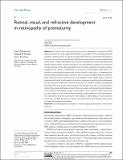| dc.contributor.author | Moskowitz, Anne | en_US |
| dc.contributor.author | Hansen, Ronald M | en_US |
| dc.contributor.author | Fulton, Anne B | en_US |
| dc.date.accessioned | 2017-06-15T18:29:54Z | |
| dc.date.issued | 2016 | en_US |
| dc.identifier.citation | Moskowitz, Anne, Ronald M Hansen, and Anne B Fulton. 2016. “Retinal, visual, and refractive development in retinopathy of prematurity.” Eye and Brain 8 (1): 103-111. doi:10.2147/EB.S95021. http://dx.doi.org/10.2147/EB.S95021. | en |
| dc.identifier.issn | | en |
| dc.identifier.uri | http://nrs.harvard.edu/urn-3:HUL.InstRepos:33029860 | |
| dc.description.abstract | The pivotal role of the neurosensory retina in retinopathy of prematurity (ROP) disease processes has been amply demonstrated in rat models. We have hypothesized that analogous cellular processes are operative in human ROP and have evaluated these presumptions in a series on non-invasive investigations of the photoreceptor and post-receptor peripheral and central retina in infants and children. Key results are slowed kinetics of phototransduction and deficits in photoreceptor sensitivity that persist years after ROP has completely resolved based on clinical criteria. On the other hand, deficits in post-receptor sensitivity are present in infancy regardless of the severity of the ROP but are not present in older children if the ROP was so mild that it never required treatment and resolved without a clinical trace. Accompanying the persistent deficits in photoreceptor sensitivity, there is increased receptive field size and thickening of the post-receptor retinal laminae in the peripheral retina of ROP subjects. In the late maturing central retina, which mediates visual acuity, attenuation of multifocal electroretinogram activity in the post-receptor retina led us to the discovery of a shallow foveal pit and significant thickening of the post-receptor retinal laminae in the macular region; this is most likely due to failure of the normal centrifugal movement of the post-receptor cells during foveal development. As for refractive development, myopia, at times high, is more common in ROP subjects than in control subjects, in accord with refractive findings in other populations of former preterms. This information about the neurosensory retina enhances understanding of vision in patients with a history of ROP, and taken as a whole, raises the possibility that the neurosensory retina is a target for therapeutic intervention. | en |
| dc.language.iso | en_US | en |
| dc.publisher | Dove Medical Press | en |
| dc.relation.isversionof | doi:10.2147/EB.S95021 | en |
| dc.relation.hasversion | http://www.ncbi.nlm.nih.gov/pmc/articles/PMC5398748/pdf/ | en |
| dash.license | LAA | en_US |
| dc.subject | electroretinogram | en |
| dc.subject | psychophysics | en |
| dc.subject | retinal imaging | en |
| dc.subject | photoreceptors | en |
| dc.subject | neural retina | en |
| dc.subject | refraction | en |
| dc.title | Retinal, visual, and refractive development in retinopathy of prematurity | en |
| dc.type | Journal Article | en_US |
| dc.description.version | Version of Record | en |
| dc.relation.journal | Eye and Brain | en |
| dash.depositing.author | Moskowitz, Anne | en_US |
| dc.date.available | 2017-06-15T18:29:54Z | |
| dc.identifier.doi | 10.2147/EB.S95021 | * |
| dash.contributor.affiliated | Hansen, Ronald | |
| dash.contributor.affiliated | Fulton, Anne | |
| dash.contributor.affiliated | Moskowitz, Anne | |


